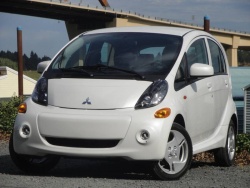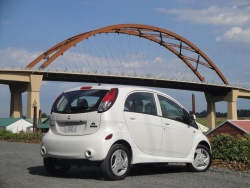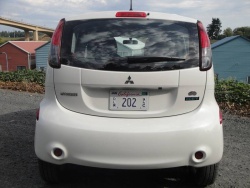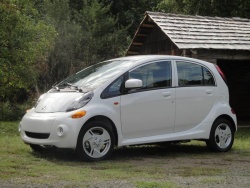 2012 Mitsubishi iMiev. Click image to enlarge |
|
More Mitsubishi iMiev reviews on Autos.ca
Manufacturer’s web site |
Review and photos by Greg Wilson
Photo Gallery:
2012 Mitsubishi iMiev
Portland, Oregon – Until recently, the promise of mass-produced electric cars from major vehicle manufacturers has always seemed like a distant goal, often delayed and extended to some future time. Now with the new Nissan Leaf, Chevrolet Volt, Tesla Roadster, and Mitsubishi iMiev (pronounced i-Meev) on sale to the public in Canada (although still in limited numbers in limited locations), and many more on the way, there is a real sense that the second coming of the electric car is finally here.
Of course, just because they’re available, doesn’t mean people will buy them. Early adopters and well-to-do trendsetters will snap up the first electric cars on the market, but mass-market consumers are naturally skeptical about new technology: there’s been plenty of criticism of electric cars’ limited driving range, high initial prices, and the lack of public recharging stations. Realistically, electric cars have a long way to go before they can compete with traditional vehicles on price, range and convenience. Still, it’s likely that their high initial start-up costs and limited technology will improve with mass production and real-world experience.
  2012 Mitsubishi iMiev. Click image to enlarge |
In fact, there have already been improvements in electric cars: when we previewed the Japanese version of the iMiev last year which has been on sale in Japan since 2009, we found it to be an ideal urban car with room for four adults, but its maximum driving range of 120 km, and even less if driven aggressively with electricity-depleting accessories like the air conditioner or heater turned on, limited its usefulness. And its retail price in Japan was approximately CAN$49,000, a lot of money for a subcompact car.
Compare that with the new-for-North-America 2012 Mitsubishi iMiev which has a maximum of driving range of 155 km and is 110 mm (4.3 in.) wider than the Japanese and European iMievs with correspondingly more passenger and cargo space, and improved handling and stability. It starts at $32,998 – still a lot of money for a subcompact car, but less than the original iMiev.
The iMiev’s 330-volt lithium-ion battery pack, 49 kW/66 hp electric motor, onboard charger, and DC converter are hidden under the floor, over the rear wheels, and under the trunk floor between the frame rails for crash protection (in case of a collision, the battery automatically shuts down). This arrangement allows the iMiev to have a long wheelbase with minimal front and rear overhangs, and lowers the centre of gravity for better handling and stability. For such a tall vehicle (1615 mm/63.6 in.), we found that the iMiev leans very little when cornering briskly, and its handling seems mainly hindered by its skinny, low rolling-resistance Dunlop Enasave 175/50R 15-inch tires. To help keep the shiny side up, all iMievs include the latest safety nannies: electronic traction and stability control, anti-lock brakes and emergency brake assist, brake override (if both accelerator and brake pedal are depressed), and tire pressure monitoring system.
 2012 Mitsubishi iMiev. Click image to enlarge |
Mitsubishi cites a 0 to 80 km/h time of 10.6 seconds for the iMiev but didn’t supply us with the more traditional 0 to 100 km/h time for comparison with conventional vehicles, probably because the iMiev would look rather slow. But as an urban car, zero to 100 km/h times are less relevant than zero to 50 km/h times: the iMiev is arguably quicker from a stop light than many cars because 100 per cent of its electric motor’s torque (145 lb.-ft.) is developed right from initial throttle at 0 rpm. The iMiev is perky and responsive around town, and eerily quiet.
On the highway, the iMiev cruises along nicely and has a maximum speed of 130 km/h, but seems to suck back the power at higher speeds, especially going uphill! Regenerative braking recharges the battery when going downhill or braking and the brake pedal needs very little pressure to stop the car. Though Mitsubishi cites a maximum range is 155 km, the U.S. EPA rates its range at only 100 km (in a mix of 55 per cent city/45 per cent highway driving).











